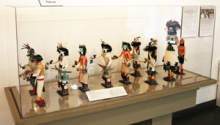Article
In the Zuni tradition, the Council of the Gods consists of a dynamic grouping of significant deities, each representing a powerful natural phenomenon or a cardinal direction and the characteristics associated with that direction. During the winter ceremony of Shalako, it is believed that the Council enters the Zuni pueblo to visit and to celebrate the turn of the year with the people. During this ceremony, only five members of the Council actually participate, personified by men who train carefully for the event. The Gods who pass through the pueblo are Saiyatasha, or Longhorn, Rain God of the North, Hu-tu-tu, deputy to Saiyatasha and Rain God of the South, two Yamuhakto (wood gatherers), one from the East, and the other from the West, and lastly the Fire God, a deputy to the Sun Father, usually personified by a young boy. These figures are the primary Council members and lead the dancing processional through the pueblo, but they are also accompanied by two Salamobia warrior figures and a group of Mudhead dancers, or Koyemsi, who work together to oversee the procedures and maintain order during the ceremony.
"Council of the Gods, Zuni Shalako Procession, Museum of Man, Sand Diego, CA, August 7, 2012" by Tim Evanson is licensed under CC BY-SA.
Manuscripts
A03 The Boy Who Made Dragonfly (06-08) p. 35
A03 The Boy Who Made Dragonfly (06-08) p. 36
A03 The Boy Who Made Dragonfly (06-08) p. 37
A03 The Boy Who Made Dragonfly (06-08) p. 39
A04 Dance Hall of the Dead (04-06) p. 11
A04 Dance Hall of the Dead (04-06) p. 68
A04 Dance Hall of the Dead (04-06) p. 79
A04 Dance Hall of the Dead (04-06) p. 82
A04 Dance Hall of the Dead (04-06) p. 84
A04 Dance Hall of the Dead (04-06) p. 88
A04 Dance Hall of the Dead (04-06) p. 89
A04 Dance Hall of the Dead (04-06) p. 103
A04 Dance Hall of the Dead (04-06) p. 105
A04 Dance Hall of the Dead (04-06) p. 112
References
Fergusson, Erna
1931 Dancing Gods: Indian Ceremonials of New Mexico and Arizona. Albuquerque:
University of New Mexico Press: 91-113.
Stevenson, Matilda Coxe
1898 Zuni Ancestral Gods and Masks. American Anthropologist 11 (2): 33-40.

